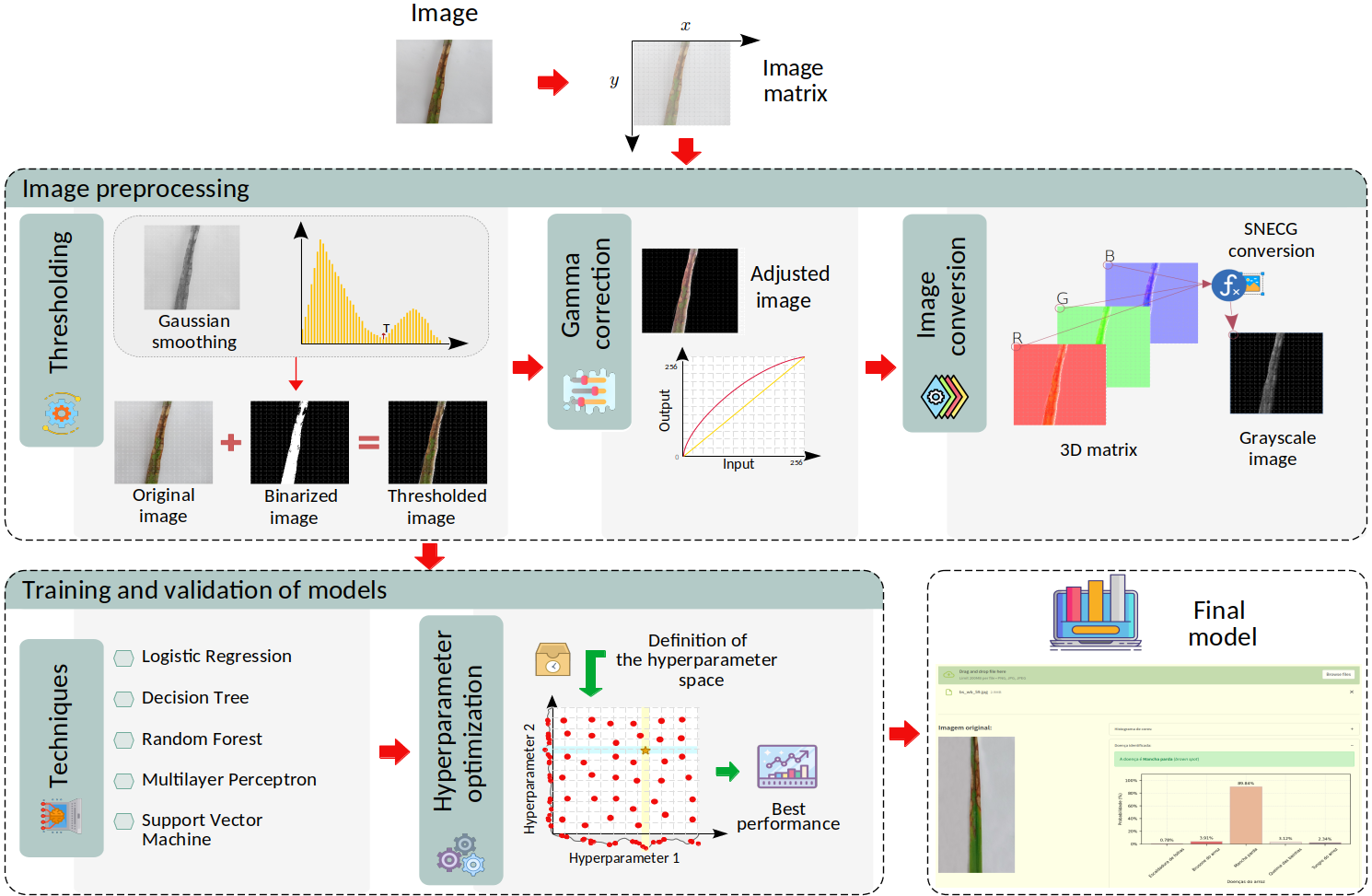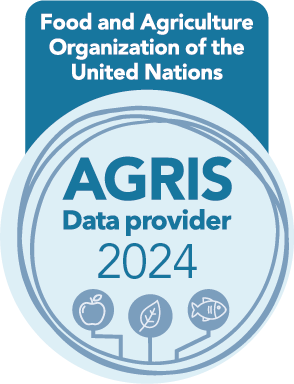Rice leaf disease detection using the Stretched Neighborhood Effect Color to Grayscale method and Machine Learning
DOI:
https://doi.org/10.17268/sci.agropecu.2025.011Palabras clave:
leaf disease, disease classification, disease detection, image processing, machine learning, random forestResumen
The emergence of Machine Learning (ML) technologies and their integration into agriculture has demonstrated a significant impact on disease detection in crops, enabling continuous monitoring and enhancing risk planning and management. This study applied image processing techniques such as thresholding, gamma correction, and the Stretched Neighborhood Effect Color to Grayscale (SNECG) method, alongside ML, to develop a predictive model for identifying five types of rice diseases. The ML techniques used included Logistic Regression, Multilayer Perceptron, Support Vector Machines, Decision Trees, and Random Forests (RF). Hyperparameters were optimized and evaluated through 5-fold cross-validation. In the results, the SNECG method successfully converted images to grayscale, capturing essential features of lesions on rice leaves. The ML models developed with these techniques showed evaluation metrics exceeding 80%, with the RF model (precision = 88.31%) demonstrating superior performance. Additionally, the RF model was integrated into an interface designed for agricultural decision-making. The practical application of the developed model could significantly improve the ability to detect and manage diseases in rice crops.
Citas
Alpaydin, E. (2021). Introduction to machine learning. MIT press. https://doi.org/10.7551/mitpress/13811.001.0001
Akyol, K. (2023). Handling hypercolumn deep features in machine learning for rice leaf disease classification. Multimedia Tools and Applications, 82(13), 19503-19520. https://doi.org/10.1007/s11042-022-14318-5
Azim, M. A., Islam, M. K., Rahman, M. M., & Jahan, F. (2021). An effective feature extraction method for rice leaf disease classification. Telkomnika (Telecommunication Computing Electronics and Control), 19(2), 463-470. http://doi.org/10.12928/telkomnika.v19i2.16488
Belgiu, M., & Drăguţ, L. (2016). Random forest in remote sensing: A review of applications and future directions. ISPRS journal of photogrammetry and remote sensing, 114, 24–31. https://doi.org/10.1016/j.isprsjprs.2016.01.011
Carcea, M. (2021). Value of wholegrain rice in a healthy human nutrition. Agriculture, 11(8), 720. https://doi.org/10.3390/agriculture11080720
Chicco, D. (2020). The advantages of the Matthews correlation coefficient (MCC) over F1 score and accuracy in binary classification evaluation. BMC Genomics, 21, 6. https://doi.org/10.1186/s12864-019-6413-7
Elmitwally, N. S., Tariq, M., Khan, M. A., Ahmad, M., Abbas, S., & Alotaibi, F. M. (2022). Rice Leaves Disease Diagnose Empowered with Transfer Learning. Computer Systems Science & Engineering, 42(3). https://doi.org/10.32604/csse.2022.022017
Food and Agriculture Organization of the United Nations, FAO (2019). Crops and livestock products. FAOSTAT. https://www.fao.org/faostat/en/#data/QCL
Food and Agriculture Organization of the United Nations, FAO (2009). La agricultura mundial en la perspectiva del año 2050. https://www.fao.org/fileadmin/templates/wsfs/docs/Issues_papers/Issues_papers_SP/La_agricultura_mundial.pdf
Feng, L., Wu, B., Zhu, S., Wang, J., Su, Z., Liu, F., He, Y., & Zhang, C. (2020). Investigation on data fusion of multisource spectral data for rice leaf diseases identification using machine learning methods. Frontiers in plant science, 11, 577063. https://doi.org/10.3389/fpls.2020.577063
Foreign Agricultural Service, USDA (2025). Production - Rice. https://www.fas.usda.gov/data/production/commodity/0422110
Gareth, J., Daniela, W., Trevor, H., & Robert, T. (2013). An introduction to statistical learning: with applications in R. Spinger. https://doi.org/10.1080/24754269.2021.1980261
Gonzales, R. C., & Wintz, P. (2017). Digital image processing. Addison Wesley Longman Publishing Co., Inc.
Gonzalez, R. C. & Woods, R. E. (2018). Digital image processing. Pearson.
IPM Images, IPM (2023). Agricultural Systems : Rice. IPM Images. https://www.ipmimages.org/browse/Areasubs.cfm?area=125
International Rice Research Institute, IRRI (2023). Pests and diseases: Diseases. IRRI Knowledge Bank. http://www.knowledgebank.irri.org/step-by-step-production/growth/pests-and-diseases/diseases
Islam, M., Dinh, A., Wahid, K., & Bhowmik, P. (2017). Detection of potato diseases using image segmentation and multiclass support vector machine. In 2017 IEEE 30th canadian conference on electrical and computer engineering (CCECE) (pp. 1-4). IEEE. https://doi.org/10.1109/CCECE.2017.7946594
Jiang, Z., Dong, Z., Jiang, W., & Yang, Y. (2021). Recognition of rice leaf diseases and wheat leaf diseases based on multi-task deep transfer learning. Computers and Electronics in Agriculture, 186, 106184. https://doi.org/10.1016/j.compag.2021.106184
Jordan, M. I., & Mitchell, T. M. (2015). Machine learning: Trends, perspectives, and prospects. Science, 349(6245), 255-260. https://doi.org/10.1126/science.aaa8415
Kanan, C., & Cottrell, G. W. (2012). Color-to-grayscale: does the method matter in image recognition? PloS one, 7(1), e29740. https://doi.org/10.1371/journal.pone.0029740
Kartikeyan, P., & Shrivastava, G. (2021). Review on emerging trends in detection of plant diseases using image processing with machine learning. International Journal of Computer Applications, 975(8887), 39-48. https://doi.org/10.5120/ijca2021920990
Kawtrakul, A., Tippayarak, P., Andres, F., & Ujjin, S. (2015). Personal warning service for pest management using a crop calendar and bus model. In Proceedings of the 7th International Conference on Management of Computational and Collective Intelligence in Digital Ecosystems (pp. 242–249). https://doi.org/10.1145/2857218.285727
Khan, M. A., Khan, R., & Ansari, M. A. (2022). Application of Machine Learning in Agriculture. Academic Press.
Kumar, K. K. & Kannan, E. (2022). Detection of rice plant disease using AdaBoostSVM classifier. Agronomy journal, 114(4), 2213-2229. https://doi.org/10.1002/agj2.21070
Latif, G., Abdelhamid, S. E., Mallouhy, R. E., Alghazo, J., & Kazimi, Z. A. (2022). Deep learning utilization in agriculture: Detection of rice plant diseases using an improved CNN model. Plants, 11(17), 2230. https://doi.org/10.3390/plants11172230
Lim, W. H. & Isa, N. A. M. (2011). Color to grayscale conversion based on neighborhood pixels effect approach for digital image. In Proc. int. conf. on electrical and electronics engineering (pp. 157-161).
Lu, Y., Yi, S., Zeng, N., Liu, Y., & Zhang, Y. (2017). Identification of rice diseases using deep convolutional neural networks. Neurocomputing, 267, 378–384. https://doi.org/10.1016/j.neucom.2017.06.023
Ma, K., Zhao, T., Zeng, K., & Wang, Z. (2015). Objective quality assessment for color-to-gray image conversion. IEEE Transactions on Image Processing, 24(12), 4673-4685. https://doi.org/10.1109/TIP.2015.246001
Marsland, S. (2015). Machine learning: an algorithmic perspective. Chapman and Hall/CRC.
Mendeley (2022). Mendeley data. https://data.mendeley.com
Nakandakari, D. L. H. (2017). Pest management issues in rice cultivation (Oryza sativa L.) [Master's thesis, National Agrarian University La Molina]. UNALM-Institutional Repository. https://hdl.handle.net/20.500.12996/2988
Nixon, M. & Aguado, A. (2019). Feature extraction and image processing for computer vision. Academic press. https://doi.org/10.1016/C2011-0-06935-1
Rafael, C., Richard, E., Woods, L. S., & Steven, L. (2020). Digital image using matlab processing. Person Prentice Hall, Lexington.
Rahman, H. A. A., Wah, Y. B., He, H., & Bulgiba, A. (2015). Comparisons of ADABOOST, KNN, SVM and logistic regression in classification of imbalanced dataset. In Soft Computing in Data Science: First International Conference, SCDS 2015, Putrajaya, Malaysia, September 2-3, 2015, Proceedings 1 (pp. 54-64). Springer. https://doi.org/10.1007/978-981-287-936-3_6
Rajinikanth, V., Raja, N. S. M., & Dey, N. (2020). A Beginner’s Guide to Multilevel Image Thresholding. CRC Press. https://doi.org/10.1201/9781003049449
Rallapalli, S., & Saleem Durai, M. A. (2021). A contemporary approach for disease identification in rice leaf. International Journal of System Assurance Engineering and Management, 1-11. https://doi.org/10.1007/s13198-021-01159-y
Reddy, S. R., Varma, G. S., & Davuluri, R. L. (2022). Deep neural network (dnn) mechanism for identification of diseased and healthy plant leaf images using computer vision. Annals of Data Science, 11(1), 243-272. https://doi.org/10.1007/s40745-022-00412-w
Rodriguez, E. Y. A., Gamboa, A. A. R., Rodriguez, E. C. A., da Silva, A., Rizol, P. M. S. R., & Marins, F. A. S. (2022). Comparison of adaptative neuro-fuzzy inference system (ANFIS) and machine learning algorithms for electricity production forecasting. IEEE Latin America Transactions, 20(10):2288–2294. https://doi.org/10.1109/TLA.2022.9885166
Rodríguez, E. Y. A., Rodríguez, E. C. A., Silva, A. F. d., Rizol, P. M. S. R., Miranda, R. d. C., & Marins, F. A. S. (2024a). A decision-making framework with machine learning for transport outsourcing based on cost prediction: an application in a multinational automotive company. International Journal of Information Technology, 16(3), 1495-15. https://doi.org/10.1007/s41870-023-01707-8
Rodríguez, E. Y. A., Rodríguez, E. C. A., Silva, A. F. d., Rizol, P. M. S. R., Miranda, R. d. C., & Marins, F. A. S. (2024b). Analysis of machine learning integration into supply chain management. International Journal of Logistics Systems and Management, 47(3), 327–355. https://doi.org/10.1504/IJLSM.2021.10042452
Rodríguez, E. Y. A., Rodríguez, E. C. A., Fernández, J. P. S., Nascimento, L. F. C., Silva, A. F. d., & Marins, F. A. S. (2022). Inteligencia artificial para detección y diagnóstico de enfermedades en cultivos de arroz. In 5to Congreso estudiantil de Inteligencia Artificial aplicada a la ingeniería y tecnología. https://virtual.cuautitlan.unam.mx/intar/ceiaait/wp-content/uploads/sites/14/2023/02/Int-Art-10-18.pdf
Savary, S., Willocquet, L., Pethybridge, S. J., Esker, P., McRoberts, N., & Nelson, A. (2019). The global burden of pathogens and pests on major food crops. Nature ecology & evolution, 3, 430–493. https://doi.org/10.1038/s41559-018-0793-y
Seck, P. A., Diagne, A., Mohanty, S., & Wopereis, M. C. S. (2012). Crops that feed the world 7: Rice. Food Security, 4(1), 7–24. https://doi.org/10.1007/s12571-012-0168-1
Sethy, P. K., Barpanda, N. K., Rath, A. K., & Behera, S. K. (2020). Deep feature-based rice leaf disease identification using support vector machine. Computers and Electronics in Agriculture, 175, 105527. https://doi.org/10.1016/j.compag.2020.105527
Sharma, R., Singh, A., Kavita, Jhanjhi, N. Z., Masud, M., Jaha, E. S., & Verma, S. (2022). Plant disease diagnosis and image classification using deep learning. Computers, Materials & Continua, 71(2), 2125–2140. https://doi.org/10.32604/cmc.2022.020017
Sheykhmousa, M., Mahdianpari, M., Ghanbari, H., Mohammadimanesh, F., Ghamisi, P., & Homayouni, S. (2020). Support vector machine versus random forest for remote sensing image classification: A meta-analysis and systematic review. IEEE Journal of Selected Topics in Applied Earth Observations and Remote Sensing, 13, 6308-6325. https://doi.org/10.1109/JSTARS.2020.3026724
Tian, L., Xue, B., Wang, Z., Li, D., Yao, X., Cao, Q., Zhu, Y., Cao, W., & Cheng, T. (2021). Spectroscopic detection of rice leaf blast infection from asymptomatic to mild stages with integrated machine learning and feature selection. Remote Sensing of Environment, 257, 112350. https://doi.org/10.1016/j.rse.2021.112350
Upadhyay, S. K., & Kumar, A. (2022). A novel approach for rice plant diseases classification with deep convolutional neural network. International Journal of Information Technology, 14(1), 185-199. https://doi.org/10.1007/s41870-021-00817-5
Zhai, Z., Martínez, J. F., Beltran, V., & Martínez, N. L. (2020). Decision support systems for agriculture 4.0: Survey and challenges. Computers and Electronics in Agriculture, 170, 105256. https://doi.org/10.1016/j.compag.2020.105256
Zhu, Q. (2020). On the performance of Matthews correlation coefficient (MCC) for imbalanced dataset. Pattern Recognition Letters, 136, 71-80. https://doi.org/10.1016/j.patrec.2020.03.030

Descargas
Publicado
Cómo citar
Número
Sección
Licencia
Derechos de autor 2025 Scientia Agropecuaria

Esta obra está bajo una licencia internacional Creative Commons Atribución-NoComercial 4.0.
Los autores que publican en esta revista aceptan los siguientes términos:
a. Los autores conservan los derechos de autor y conceden a la revista el derecho publicación, simultáneamente licenciada bajo una licencia de Creative Commons que permite a otros compartir el trabajo, pero citando la publicación inicial en esta revista.
b. Los autores pueden celebrar acuerdos contractuales adicionales separados para la distribución no exclusiva de la versión publicada de la obra de la revista (por ejemplo, publicarla en un repositorio institucional o publicarla en un libro), pero citando la publicación inicial en esta revista.
c. Se permite y anima a los autores a publicar su trabajo en línea (por ejemplo, en repositorios institucionales o en su sitio web) antes y durante el proceso de presentación, ya que puede conducir a intercambios productivos, así como una mayor citación del trabajo publicado (ver efecto del acceso abierto).




